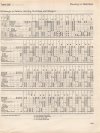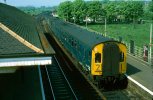I have been doing a bit of research on Edinburgh to Glasgow times since dieselisation, but cannot find a TT for the 1960 to 1971 (Class 126 DMUs), can anyone fill in the blank ? And/or check my stats ?
1958 to 1972 - Class 126 DMUs (2 power cars to one trailer, 1200hp) - 70mph max - fastest time ????
1975 to 1980 - 2 x Class 27s + 6 MkIIs - 90mph max - 45 to 47 mins with 2 stops (my 1975 TT also lists some non stops in 45 min ! )
1980 to 1990 - Class 47 + 6 MkIIIs + 1 MkII DVT - 100mph max - 48min with 3 stops (1987 TT)
1990 to 2000 - Class 158s - 90mph max - 50 min with 3 stops (1998 TT)
2000 to 2018 - Class 170s - 100mph max - 49 min with 3 stops (2018 TT)
2018 on - Class 385s (elec) - 100mph max - 48 min with 5 stops (current Scotrail TT pdf Online)
A few observations, it hasn't got much faster has it, albeit there is now far more services that make more calls and still do it in 48 min.
I was able to do this research fairly quickly using my old TTs, how will future historians do the same when it's all (temporary) Online ?
What were the times in the era steam ?
1956 to 1971 was the Swindon 79xxx series InterCity DMUs, these did not survive long enough to gain TOPS Class numbers.
Original service pattern was hourly, with some infils by trains from England such as the Queen of Scots.
Journey time was originally one hour mostly, by the early 1960s it was usually 1 or two stops and 55-60 mins, by the late-1960s a half-hourly pattern as outlined by Cheshire Scot was established. Linespeed was 75mph, but the 79xxx were nominal 70mph max.
1971-1980 was the 27s push-pull on a rake of six specially equipped Mk2Z. These had their vacuum tread brakes replaced with a two-stage air disc brake system and also through 27-way multicore cabling and through Blue Star control air pipes.
90mph running was authorised, the line being resignalled to permit this. Schedules were cut to 43 mins Haymarket only or 45 Falkirk and Haymarket.
Reliability issues meant that soon 2 and later 4 mins recovery time was added.
From 1979 into 1980, the 47/7 and Mk3 push-pull sets with converted Mk2F DBSO driving trailers were introduced.
These were originally permitted 95mph max, but were still run on 90mph Class 27 schedules at 47-49 mins.
After reliability had been proved, the schedules were cut in May 1982 to 44 (working time 43.5)- 47 mins.
100mph running was officially authorised in May 1984, with the Schedules tightened to the fastest ever 42 mins Haymarket only or 45 mins with Falkirk High stop.
In May 1985, it was decided the business case for calling at Falkirk twice an hour was more logical than skipping it with every second train. So a regular 45 min journey with both trains calling Falkirk High and Haymarket was established.
In May 1986, it was decided to call alternate trains additionally at Polmont or Linlithgow, journey time now 48 mins.
This pattern lasted into 158 days.
In 1990, the 158s were due to arrive but delays saw redeployed 156 units cover until late in the year, the 47/7 push-pulls having been phased out in April/May.
Journey time was now 50 mins, and that lasted until the 170s were introduced in 1999 and the 15 min frequency established.
Winter 1999 timetable, 15 min frequency with 170s introduced, original pattern was all trains calling Falkirk and Haymarket, two trains additionally at Linlithgow and one each additionally at Croy or Polmont. Journey time 48 mins.
At some point in the early 2000s, it briefly reverted to half-hourly due to training issues compounded by strikes.
From Winter 2002 though it was back to every 15 mins, but with the now familiar pattern of Croy, Falkirk, Haymarket or Falkirk, Polmont, Linlithgow, Haymarket as stops.
Then we get into electrification and 385 territory.
The steam era was a bit slower, though the LNER made a special point of making up specific trainsets for the captive services on the route, it was considered an important route even then. There wasn't a set pattern, you might have called it approximately hourly but it wasn't at set departure mins every hour. Journey time was 58-77 mins depending on stops (1939 LNER timetable).


